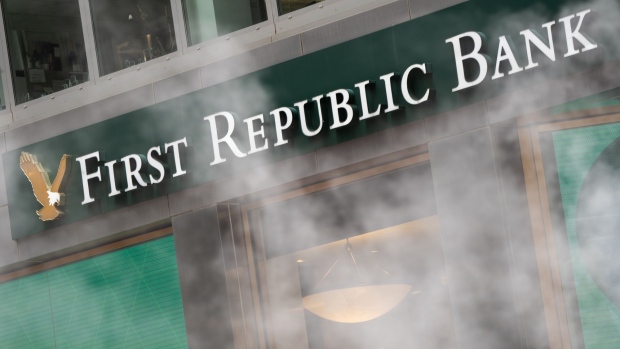Mar 10, 2023
First Republic, Regional Peers Try to Boost Confidence After SVB
, Bloomberg News

(Bloomberg) -- First Republic Bank wanted to make clear Friday that its liquidity position “remains very strong” and it has a “very well diversified” deposit base.
Some investors weren’t entirely buying it. The stock tumbled 15%, extending the San Francisco-based bank’s slide to 34% this week.
One customer at First Republic’s Menlo Park, California branch wasn’t buying it either. He told a clerk he had a simple request: “I would like to withdraw one million dollars,” he said, before being ushered into a private office.
The bank wasn’t alone in seeking to reassure shareholders after the sudden collapse of SVB Financial Group’s Silicon Valley Bank into receivership. A number of smaller, regional lenders came out with their own statements vouching for their financial stability after the failure spooked investors already reeling from Silvergate Capital Corp.’s decision to wind down just days before.
First Republic sought to distance its business from the woes that hit Silicon Valley Bank, whose highly concentrated deposit base precipitated its downfall. First Republic said in a regulatory filing Friday that no single sector represented more than 9% of its deposits. The technology sector specifically represents only 4% of total such holdings, it said.
A representative for the bank didn’t immediately respond to messages seeking comment.
Silicon Valley Bank’s collapse reverberated through the financial sector. The KBW Bank Index dropped the most in a week since March 2020.
Western Alliance Bancorp. shares closed down 21% Friday, their lowest since November 2020. The company said its liquidity remained robust while “asset quality remains excellent.” A representative for Western Alliance didn’t immediately respond to a phone call seeking comment.
Signature Bank, which banks digital-asset clients, struck a similar tone in a statement Thursday. A representative for the bank didn’t immediately respond to a request for further comment.
Bank Financials
When compared to Silicon Valley Bank, First Republic’s financial statements reveal marked differences in financial metrics. Silicon Valley Bank was sitting on heavy unrealized losses on its bond investments — more than 120% of its tangible equity at the end of 2022 — that could quickly chip away at capital if the bank had to sell those securities to raise cash.
The losses in First Republic’s held-to-maturity book were a much more manageable 35% of tangible equity. And while more than 90% of Silicon Valley Bank’s deposits weren’t insured by the Federal Deposit Insurance Corp., that figure at First Republic was 68%. First Republic consumer deposits have an average account size of less than $200,000, while for business deposits it’s less than $500,000.
Customer Queries
Despite its assurances, First Republic customers were still asking questions. At the same Menlo Park branch where a customer asked about withdrawing $1 million, customers formed an orderly queue, some wearing AirPods while discussing what had happened at Silicon Valley Bank.
One quizzed the staff on whether a transaction through Rippling, a payroll software company which warned it was impacted by the SVB collapse, had managed to go through yet.
Another customer had decided to research it himself. Timothy Corrigan, an interior designer with offices in Los Angeles and Paris and a roster of Hollywood celebrities and company leaders, checked out its financials. His client testimonial on First Republic’s website touts the competitive exchange rates he’s received from the bank for doing international business. He said SVB’s failure immediately raised a red flag over knock-on effects for First Republic, until he saw fundamental differences in their investment portfolios.
“I came away reassured of their solidity,” he said.
--With assistance from Priya Anand, Margi Murphy and Sarah McGregor.
©2023 Bloomberg L.P.





